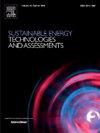Implementation and analysis of switched-capacitor multilevel inverters in solar photovoltaic system
IF 7.1
2区 工程技术
Q1 ENERGY & FUELS
Sustainable Energy Technologies and Assessments
Pub Date : 2025-02-10
DOI:10.1016/j.seta.2025.104227
引用次数: 0
Abstract
Recently, switched capacitors (SC) based multilevel inverter (MLI) concepts are employed with renewable energy (RE) sources for industry and various other applications. Among the RE sources, photovoltaic (PV) source of energy is mostly employed for the electric power generation. To maximize power generation from PV source, fuzzy logic controller (FLC) technique is used to track the maximum power point (MPP). By FLC, the system achieves dynamic and adaptive control, enabling efficient handling of nonlinearities and variations in solar irradiance and load conditions. The FLC technique calculates reference of PV voltage to optimize energy transfer from PV system to MLI and connected loads. This paper introduces a novel approach of implementing a 7-level PV-based Switched Capacitor MLI (7L-PV-SCMLI) topology aimed to reduces the number of switch devices and Total Harmonic Distortion (THD). Furthermore, the SCMLI topology boosts the input DC voltage without requiring bulky transformers or complex circuits, ensuring a compact and cost-effective design. To calculate the firing angles for SCMLI switches, a new Anti-Predatory Particle Swarm Optimization (APSO) technique is considered. The proposed method targets to elimination of harmonic specifically tailored for 7L-PV-SCMLI systems. The self-balancing and voltage enhance features of the proposed structure is validated on MATLAB/Software platform and verified experimentally.
求助全文
约1分钟内获得全文
求助全文
来源期刊

Sustainable Energy Technologies and Assessments
Energy-Renewable Energy, Sustainability and the Environment
CiteScore
12.70
自引率
12.50%
发文量
1091
期刊介绍:
Encouraging a transition to a sustainable energy future is imperative for our world. Technologies that enable this shift in various sectors like transportation, heating, and power systems are of utmost importance. Sustainable Energy Technologies and Assessments welcomes papers focusing on a range of aspects and levels of technological advancements in energy generation and utilization. The aim is to reduce the negative environmental impact associated with energy production and consumption, spanning from laboratory experiments to real-world applications in the commercial sector.
 求助内容:
求助内容: 应助结果提醒方式:
应助结果提醒方式:


